Pore Distribution Characteristics of Different Lithofacies Shales: Evidence from Scanning Electron Microscopy
Abstract
:1. Introduction
2. Samples and Methodologies
2.1. Samples
2.2. SEM Method
2.2.1. SEM Imaging
2.2.2. Pore Extraction
3. Results and Discussion
3.1. Shale TOC, Mineral Compositions, and Lithofacies
3.2. Pore Types and Distributions of Different Lithofacies
3.2.1. Argillaceous Shale
3.2.2. Felsic-Rich Shale
3.2.3. Felsic Shales
3.2.4. Calcareous Shales
3.3. Comparison of Different Lithofacies
3.4. Comparison between SEM and MICP
4. Conclusions
Author Contributions
Funding
Data Availability Statement
Acknowledgments
Conflicts of Interest
References
- Jarvie, D.M. Shale resource systems for oil and gas; Part 2, Shale-oil resource systems. AAPG Mem. 2012, 97, 89–119. [Google Scholar]
- Sun, J.; Chen, X.; Wang, X.; Zhang, Y.; Qin, Y.; Chen, C.; Li, W.; Zhou, W. Displacement characteristics of CO2 to CH4 in heterogeneous surface slit pores. Energy Fuels 2023, 37, 2926–2944. [Google Scholar] [CrossRef]
- Hu, W.; Chen, C.; Sun, J.; Zhang, N.; Zhao, J.; Liu, Y.; Ling, Z.; Li, W.; Liu, W.; Song, Y. Three-body aggregation of guest molecules as a key step in methane hydrate nucleation and growth. Commun. Chem. 2022, 5, 33. [Google Scholar] [CrossRef]
- Chen, Z.; Liu, W.; Sun, J.; Chen, C.; Song, Y. Alanine rich amphiphilic peptides as green substitutes for hydrate inhibitors: A molecular simulation study. J. Mol. Liq. 2023, 370, 121008. [Google Scholar] [CrossRef]
- Chen, Z.; Sun, J.; Wu, P.; Liu, W.; Chen, C.; Lang, C.; Dai, S.; Zhou, W. Cyclodextrin as a green anti-agglomerant agent in oil–water emulsion containing asphalt. Fuel 2023, 335, 127041. [Google Scholar] [CrossRef]
- Liu, B.; Sun, J.; Zhang, Y.; He, J.; Fu, X.; Yang, L.; Xing, J.; Zhao, X. Reservoir space and enrichment model of shale oil in the first member of Cretaceous Qingshankou Formation in the Changling Sag, southern Songliao Basin, NE China. Pet. Explor. Dev. 2018, 48, 608–624. [Google Scholar] [CrossRef]
- Xu, L.; Chang, Q.; Yang, C.; Tao, Q.; Wang, S.; Fei, J.; Xu, S. Characteristics and oil-bearing capability of shale oil reservoirs in the Permian Lucaogou Formation, Jimusaer sag. Oil Gas Geol. 2019, 40, 535–549. [Google Scholar]
- Zhao, W.; Zhu, R.; Hu, S.; Hou, L.; Wu, S. Accumulation contribution differences between lacustrine organic-rich shales and mudstones and their significance in shale oil evaluation. Pet. Explor. Dev. 2020, 47, 1079–1089. [Google Scholar] [CrossRef]
- Zou, C.; Pan, S.; Jing, Z.; Gao, J.; Yang, Z.; Wu, S.; Zhao, Q. Shale oil and gas revolution and its impact. Acta Pet. Sin. 2020, 41, 1–12. [Google Scholar]
- Jin, Z.; Liang, X.; Bai, Z. Exploration breakthrough and its significance of Gulong lacustrine shale oil in the Songliao Basin, Northeastern China. Energ. Geosci. 2022, 3, 120–125. [Google Scholar] [CrossRef]
- Zhang, P.; Lu, S.; Lin, Z.; Duan, H.; Chang, X.; Qiu, Y.; Fu, Q.; Zhi, Q.; Wang, J.; Huang, H. Key Oil Content Parameter Correction of Shale Oil Resources: A Case Study of the Paleogene Funing Formation, Subei Basin, China. Energy Fuels 2022, 36, 5316–5326. [Google Scholar] [CrossRef]
- Lu, S.; Xue, H.; Wang, M.; Xiao, D.; Huang, W.; Li, J.; Xie, L.; Tian, S.; Wang, S.; Li, J.; et al. Several key issues and research trends in evaluation of shale oil. Acta Pet. Sin. 2016, 37, 1309–1322. [Google Scholar]
- Li, J.; Lu, S.; Cai, J.; Zhang, P.; Xue, H.; Zhao, X. Adsorbed and Free Oil in Lacustrine Nanoporous Shale: A Theoretical Model and a Case Study. Energy Fuels 2018, 32, 12247–12258. [Google Scholar] [CrossRef]
- Li, Z.; Zou, Y.; Xu, X.; Sun, J.; Li, M.; Peng, P. Adsorption of mudstone source rock for shale oil–Experiments, model and a case study. Org. Geochem. 2016, 92, 55–62. [Google Scholar] [CrossRef]
- Li, J.; Lu, S.; Xie, L.; Zhang, J.; Xue, H.; Zhang, P.; Tian, S. Modeling of hydrocarbon adsorption on continental oil shale: A case study on n -alkane. Fuel 2017, 206, 603–613. [Google Scholar] [CrossRef]
- Wang, M.; Ma, R.; Li, J.; Lu, S.; Li, C.; Guo, Z.; Li, Z. Occurrence mechanism of lacustrine shale oil in the Paleogene Shahejie Formation of Jiyang Depression, Bohai Bay Basin, China. Pet. Explor. Dev. 2019, 46, 789–802. [Google Scholar] [CrossRef]
- Zhang, P.; Lu, S.; Li, J.; Chang, X. 1D and 2D Nuclear magnetic resonance (NMR) relaxation behaviors of protons in clay, kerogen and oil-bearing shale rocks. Mar. Pet. Geol. 2020, 114, 104210. [Google Scholar] [CrossRef]
- Zargari, S.; Canter, K.; Prasad, M. Porosity evolution in oil-prone source rocks. Fuel 2015, 153, 110–117. [Google Scholar] [CrossRef]
- Hu, J.; Tang, S.; Zhang, S. Investigation of pore structure and fractal characteristics of the Lower Silurian Longmaxi shales in western Hunan and Hubei Provinces in China. J. Nat. Gas Sci. Eng. 2016, 28, 522–535. [Google Scholar] [CrossRef]
- Hu, Q.; Zhang, X.; Meng, X.; Li, Z.; Xie, Z.; Li, M. Characterization of micro-nano pore networks in shale oil reservoirs of Paleogene Shahejie Formation in Dongying Sag of Bohai Bay Basin, East China. Pet. Explor. Dev. 2017, 44, 681–690. [Google Scholar] [CrossRef]
- Zhang, P.; Lu, S.; Li, J.; Chen, C.; Xue, H.; Zhang, J. Petrophysical characterization of oil-bearing shales by low-field nuclear magnetic resonance (NMR). Mar. Pet. Geol. 2018, 89, 775–785. [Google Scholar] [CrossRef]
- Zhao, R.; Xue, H.; Lu, S.; Li, J.; Tian, S.; Wang, M.; Dong, Z. Multi-scale pore structure characterization of lacustrine shale and its coupling relationship with material composition: An integrated study of multiple experiments. Mar. Pet. Geol. 2022, 140, 105648. [Google Scholar]
- Yang, F.; Ning, Z.; Wang, Q.; Liu, H. Pore structure of Cambrian shales from the Sichuan Basin in China and implications to gas storage. Mar. Pet. Geol. 2016, 70, 14–26. [Google Scholar] [CrossRef]
- Zhu, H.; Ju, Y.; Qi, Y.; Huang, C.; Zhang, L. Impact of tectonism on pore type and pore structure evolution in organic-rich shale: Implications for gas storage and migration pathways in naturally deformed rocks. Fuel 2018, 228, 272–289. [Google Scholar] [CrossRef]
- Wang, G.; Long, S.; Peng, Y.; Ju, Y. Characteristics of Organic Matter Particles and Organic Pores of Shale Gas Reservoirs: A Case Study of Longmaxi-Wufeng Shale, Eastern Sichuan Basin. Minerals 2020, 10, 137. [Google Scholar] [CrossRef] [Green Version]
- Zhang, P.; Misch, D.; Hu, F.; Kostoglou, N.; Scahenhofer, R.F.; Liu, Z.; Meng, Q.; Bechtel, A. Porosity evolution in organic matter-rich shales (Qingshankou Fm.; Songliao Basin, NE China): Implications for shale oil retention. Mar. Pet. Geol. 2021, 130, 105319. [Google Scholar] [CrossRef]
- Ma, C.; Zhao, X.; Yang, T.; Jiang, W.; Guo, B.; Han, G.; Bi, H.; Ma, J.; Bian, C.; Zhou, K.; et al. Mineralogy, organic geochemistry, and microstructural characterization of lacustrine Shahejie Formation, Qikou Sag, Bohai Bay Basin: Contribution to understanding microcosmic storage mechanism of shale oil. J. Pet. Sci. Eng. 2022, 209, 109843. [Google Scholar] [CrossRef]
- Kelly, S.; El-Sobky, H.; Torres-Verdín, C.; Balhoff, M.T. Assessing the utility of FIB-SEM images for shale digital rock physics. Adv. Water Resour. 2016, 95, 302–316. [Google Scholar] [CrossRef]
- Li, Z.; Liu, D.; Cai, Y.; Ranjith, P.; Yao, Y. Multi-scale quantitative characterization of 3-D pore-fracture networks in bituminous and anthracite coals using FIB-SEM tomography and X-ray μ-CT. Fuel 2017, 209, 43–53. [Google Scholar] [CrossRef]
- Klaver, J.; Desbois, G.; Urai, J.L.; Littke, R. BIB-SEM study of the pore space morphology in early mature Posidonia Shale from the Hils area, Germany. Int. J. Coal Geol. 2012, 103, 12–25. [Google Scholar] [CrossRef]
- Klaver, J.; Desbois, G.; Littke, R.; Urai, J.L. BIB-SEM characterization of pore space morphology and distribution in postmature to overmature samples from the Haynesville and Bossier Shales. Mar. Pet. Geol. 2015, 59, 451–466. [Google Scholar]
- Klaver, J.; Desbois, G.; Littke, R.; Urai, J.L. BIB-SEM pore characterization of mature and post mature Posidonia Shale samples from the Hils area, Germany. Int. J. Coal Geol. 2016, 158, 78–89. [Google Scholar]
- Zhang, P.; Lu, S.; Li, J.; Chang, X.; Li, J.; Li, W.; Chen, G.; Wang, S.; Feng, W. Broad ion beam-scanning electron microscopy pore microstructure and multifractal characterization of shale oil reservoir: A case sample from Dongying Sag, Bohai Bay Basin, China. Energ. Explor. Exploit. 2020, 38, 613–628. [Google Scholar] [CrossRef] [Green Version]
- Jarvie, D.M. Shale resource systems for oil and gas; Part 1, Shale-gas resource systems. AAPG Mem. 2012, 97, 69–87. [Google Scholar]
- Shi, M.; Yu, B.; Xue, Z.; Wu, J.; Yuan, Y. Pore characteristics of organic-rich shales with high thermal maturity: A case study of the Longmaxi gas shale reservoirs from well Yuye-1 in southeastern Chongqing, China. J. Nat. Gas Sci. Eng. 2015, 26, 948–959. [Google Scholar] [CrossRef]
- Wang, S.; Li, J.; Lu, S.; Zhang, P.; Zhang, J.; Li, W. Development characteristics of organic matter pores of Marine shale in the Southeastern Chongqing, China. J. Earth Sci. Envir. 2019, 41, 721–733. [Google Scholar]
- Wang, C.; Song, Y.; Li, Z.; Jiang, Z.; Zhou, C.; Chen, Z.; Chang, J.; Hong, L. Variation in the brittle-ductile transition of Longmaxi shale in the Sichuan Basin, China: The significance for shale gas exploration. J. Pet. Sci. Eng. 2022, 209, 109858. [Google Scholar]
- Locks, R.G.; Reed, R.M.; Ruppel, S.C.; Hammes, U. Spectrum of pore types and networks in mudrocks and a descriptive classification for matrix-related mudrock pores. AAPG Bull. 2012, 96, 1071–1098. [Google Scholar] [CrossRef] [Green Version]
- Liu, X.; Lai, J.; Fan, X.; Shu, H.; Wang, G.; Ma, X.; Liu, M.; Guan, M.; Luo, Y. Insights in the pore structure, fluid mobility and oiliness in oil shales of Paleogene Funing Formation in Subei Basin, China. Mar. Pet. Geol. 2020, 114, 104228. [Google Scholar] [CrossRef]
- Xu, Y.; Lun, Z.; Pan, Z.; Wang, H.; Zhou, X.; Zhao, C.; Zhang, D. Occurrence space and state of shale oil: A review. J. Pet. Sci. Eng. 2022, 211, 110183. [Google Scholar] [CrossRef]
- Wang, X.; Wang, M.; Li, J.; Shao, H.; Deng, Z.; Wu, Y. Thermal maturity: The controlling factor of wettability, pore structure, and oil content in the lacustrine Qingshankou shale, Songliao Basin. J. Pet. Sci. Eng. 2022, 215, 110618. [Google Scholar] [CrossRef]
- Zhang, P.; Lu, S.; Li, J.; Zhang, J.; Xue, H.; Chen, C. Comparisons of SEM, Low-Field NMR, and Mercury Intrusion Capillary Pressure in Characterization of the Pore Size Distribution of Lacustrine Shale: A Case Study on the Dongying Depression, Bohai Bay Basin, China. Energy Fuels 2017, 31, 9232–9239. [Google Scholar] [CrossRef]
- Chen, Q.; Zhang, J.; Tang, X.; Li, W.; Li, Z. Relationship between pore type and pore size of marine shale: An example from the Sinian–Cambrian formation, upper Yangtze region, South China. Int. J. Coal Geol. 2016, 158, 13–28. [Google Scholar] [CrossRef]
- Wang, P.; Jiang, Z.; Ji, W.; Zhang, C.; Yuan, Y.; Chen, L.; Yin, L. Heterogeneity of intergranular, intraparticle and organic pores in Longmaxi shale in Sichuan Basin, South China: Evidence from SEM digital images and fractal and multifractal geometries. Mar. Pet. Geol. 2016, 72, 122–138. [Google Scholar] [CrossRef]
- Münch, B.; Holzer, L. Contradicting Geometrical Concepts in Pore Size Analysis Attained with Electron Microscopy and Mercury Intrusion. J. Am. Ceram. Soc. 2008, 12, 4059–4067. [Google Scholar] [CrossRef]
- Li, J.; Ma, Y.; Huang, K. Quantitative characterization of organic acid generation, decarboxylation, and dissolution in a shale reservoir and the corresponding applications—A case study of the Bohai Bay Basin. Fuel 2018, 214, 538–545. [Google Scholar] [CrossRef]
- Zhang, P.; Lu, S.; Li, J. Characterization of pore size distributions of shale oil reservoirs: A case study from Dongying sag, Bohai Bay basin, China. Mar. Pet. Geol. 2019, 100, 297–308. [Google Scholar] [CrossRef]
- Yao, Y.; Liu, D. Comparison of low-field NMR and mercury intrusion porosimetry in characterizing pore size distributions of coals. Fuel 2012, 95, 152–158. [Google Scholar] [CrossRef]
- Lubelli, B.; de Winter, D.A.M.; Post, J.A.; van Hees, R.P.J.; Drury, M.R. Cryo-FIB–SEM and MIP study of porosity and pore size distribution of bentonite and kaolin at different moisture contents. Appl. Clay Sci. 2013, 80–81, 358–365. [Google Scholar] [CrossRef]

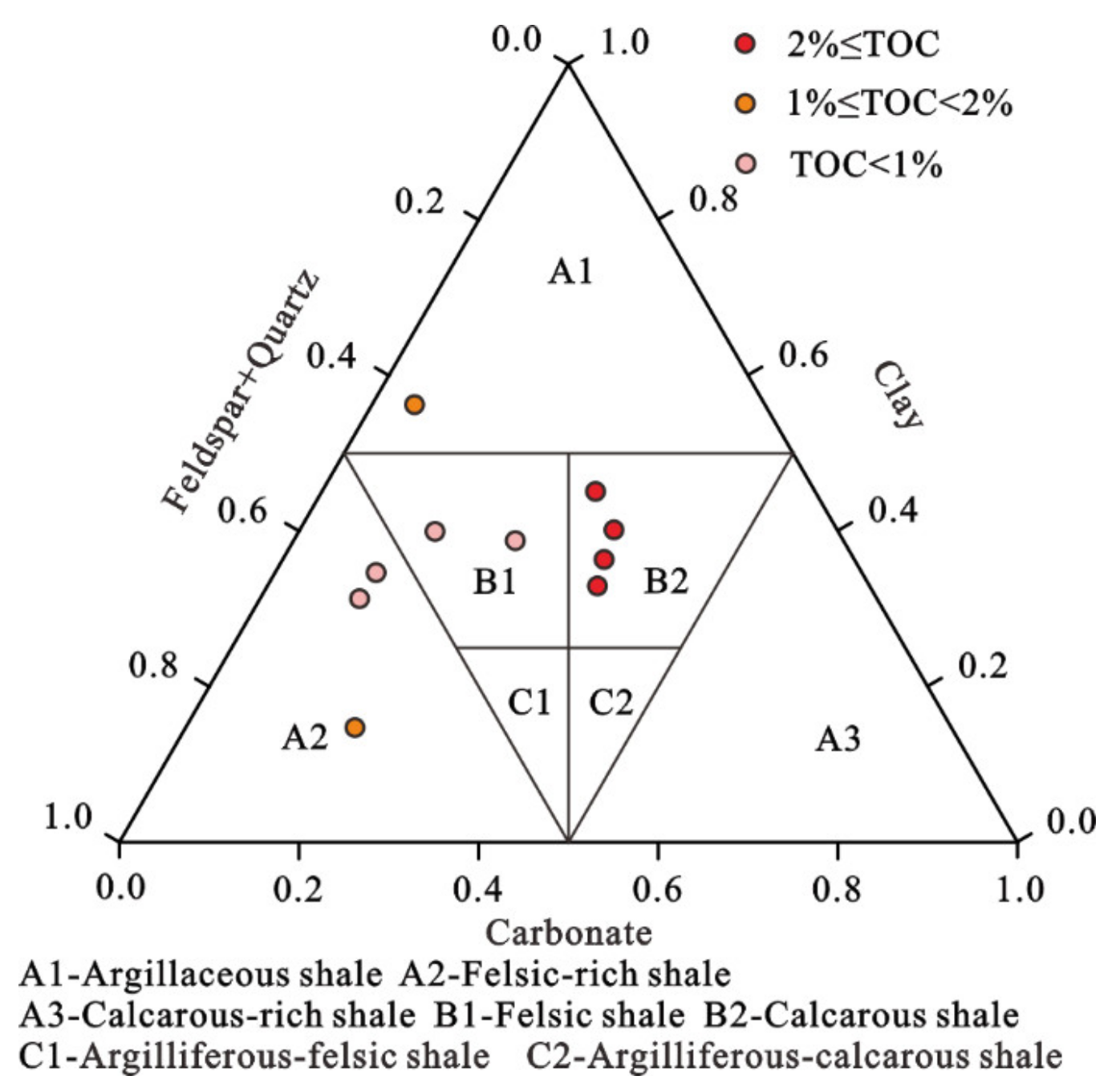

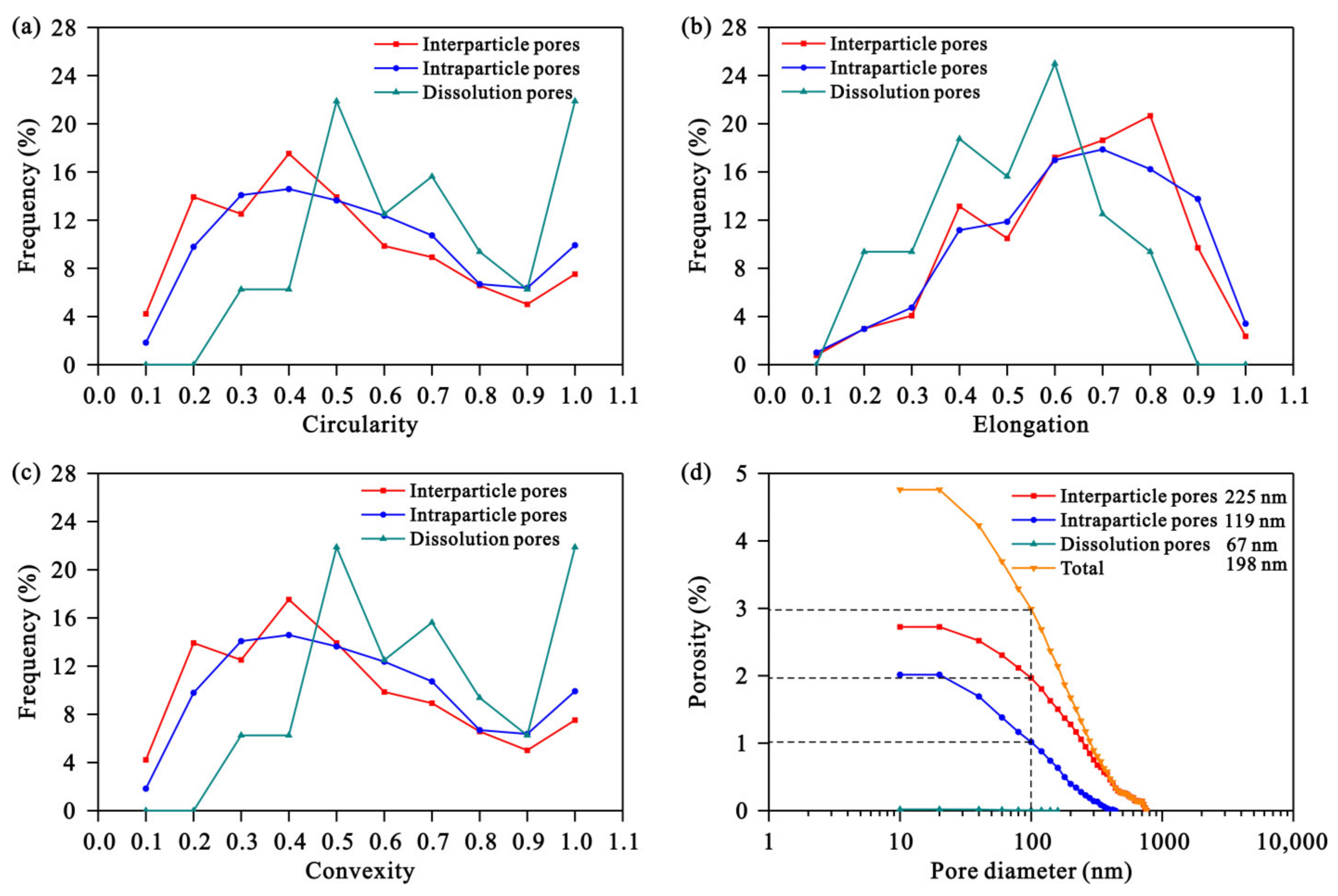
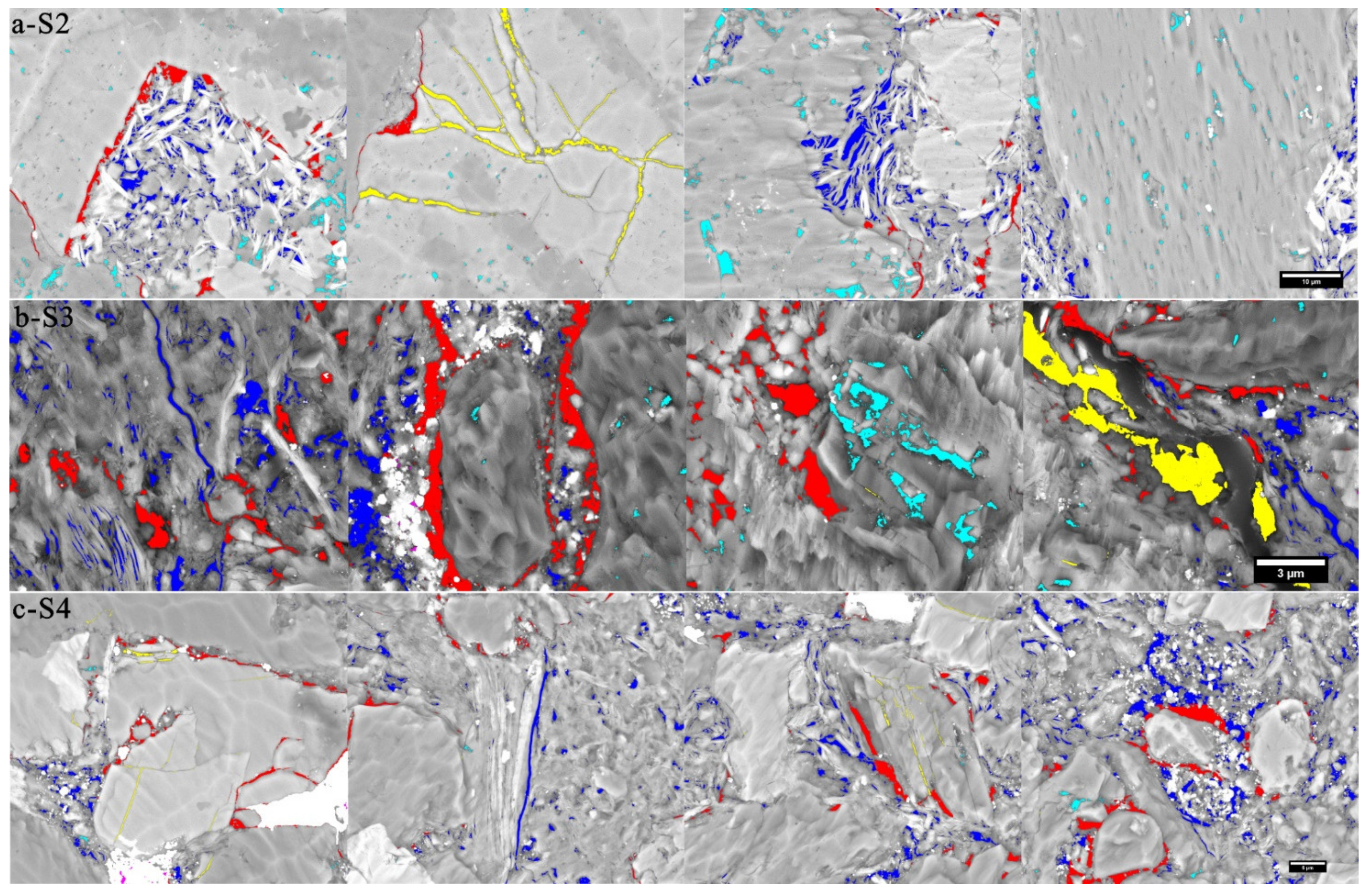
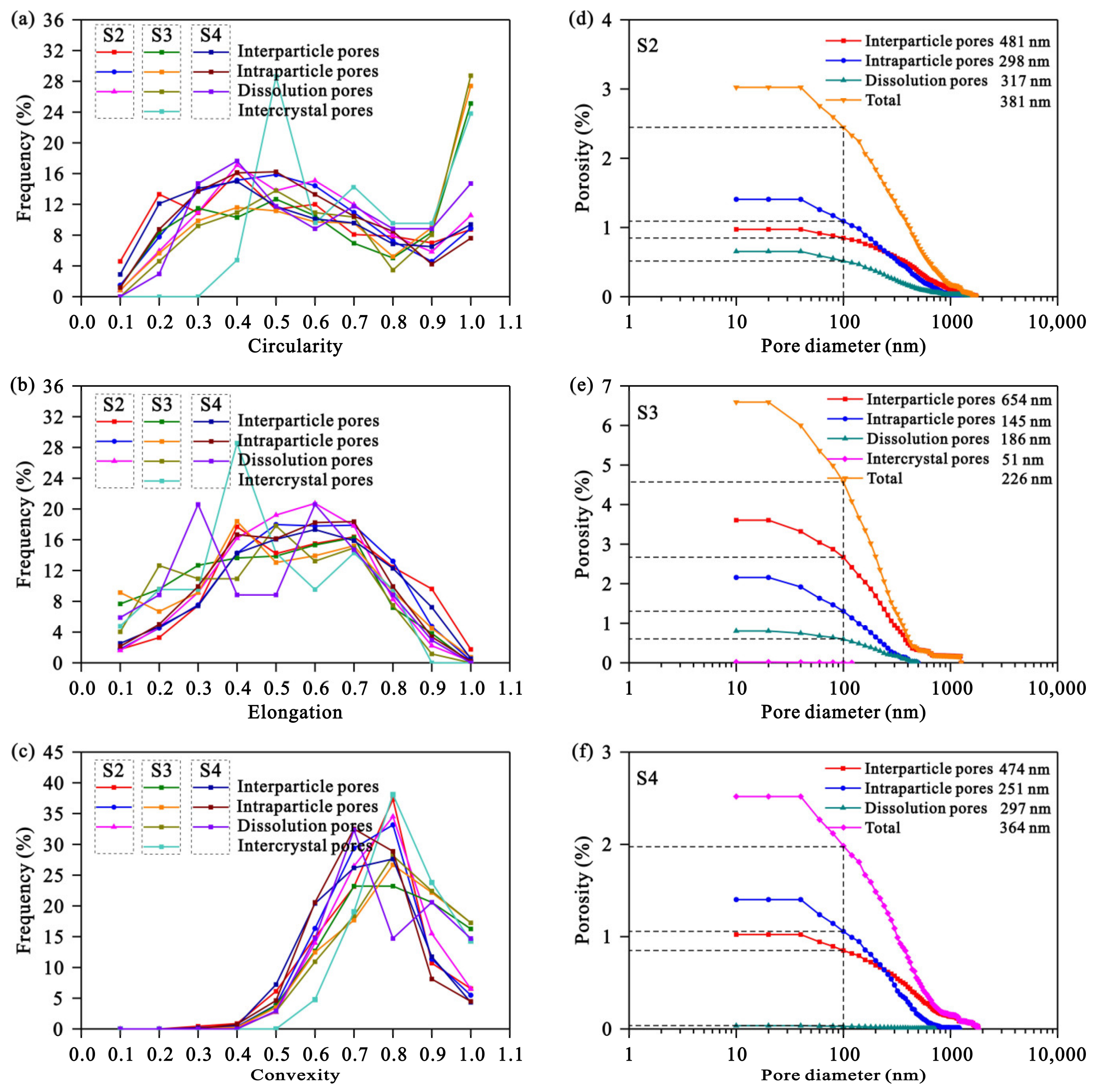



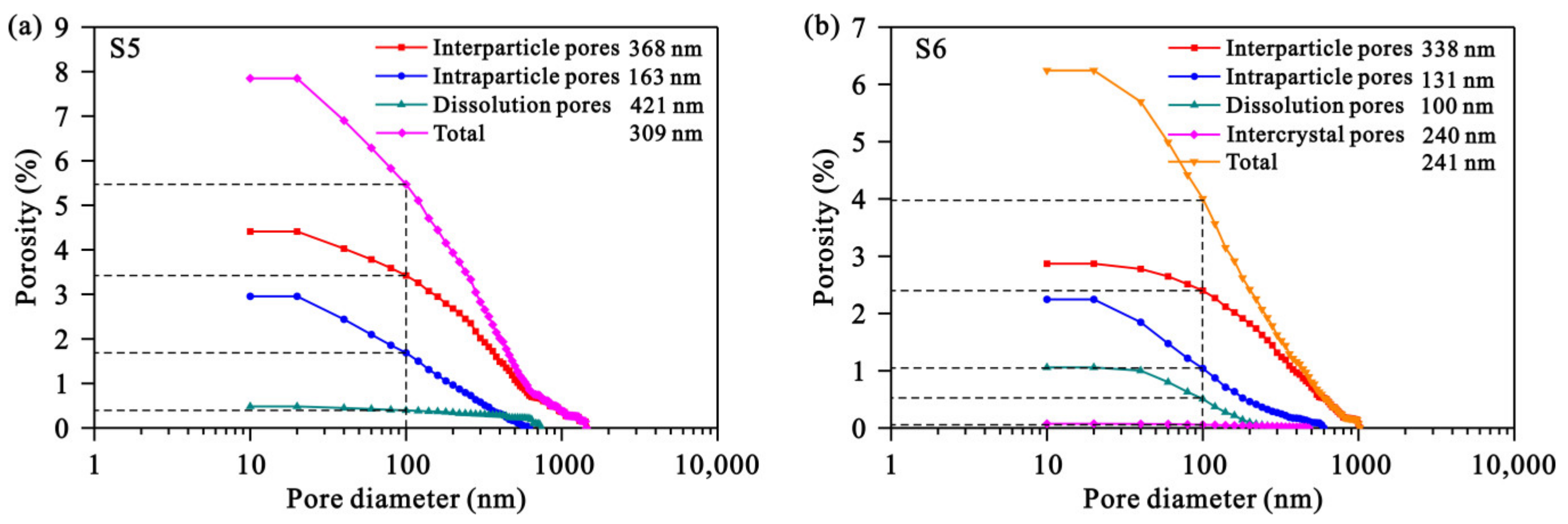



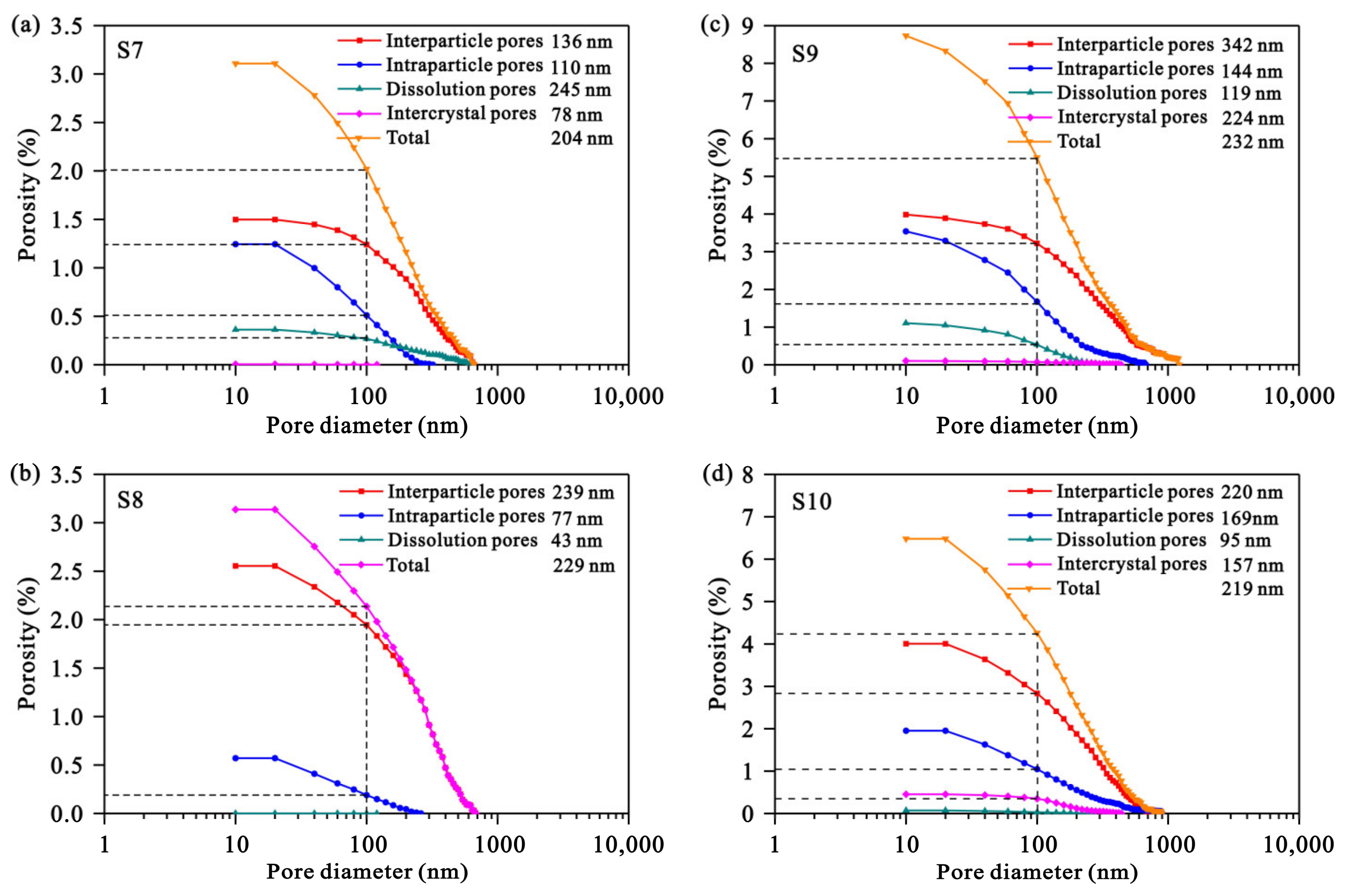


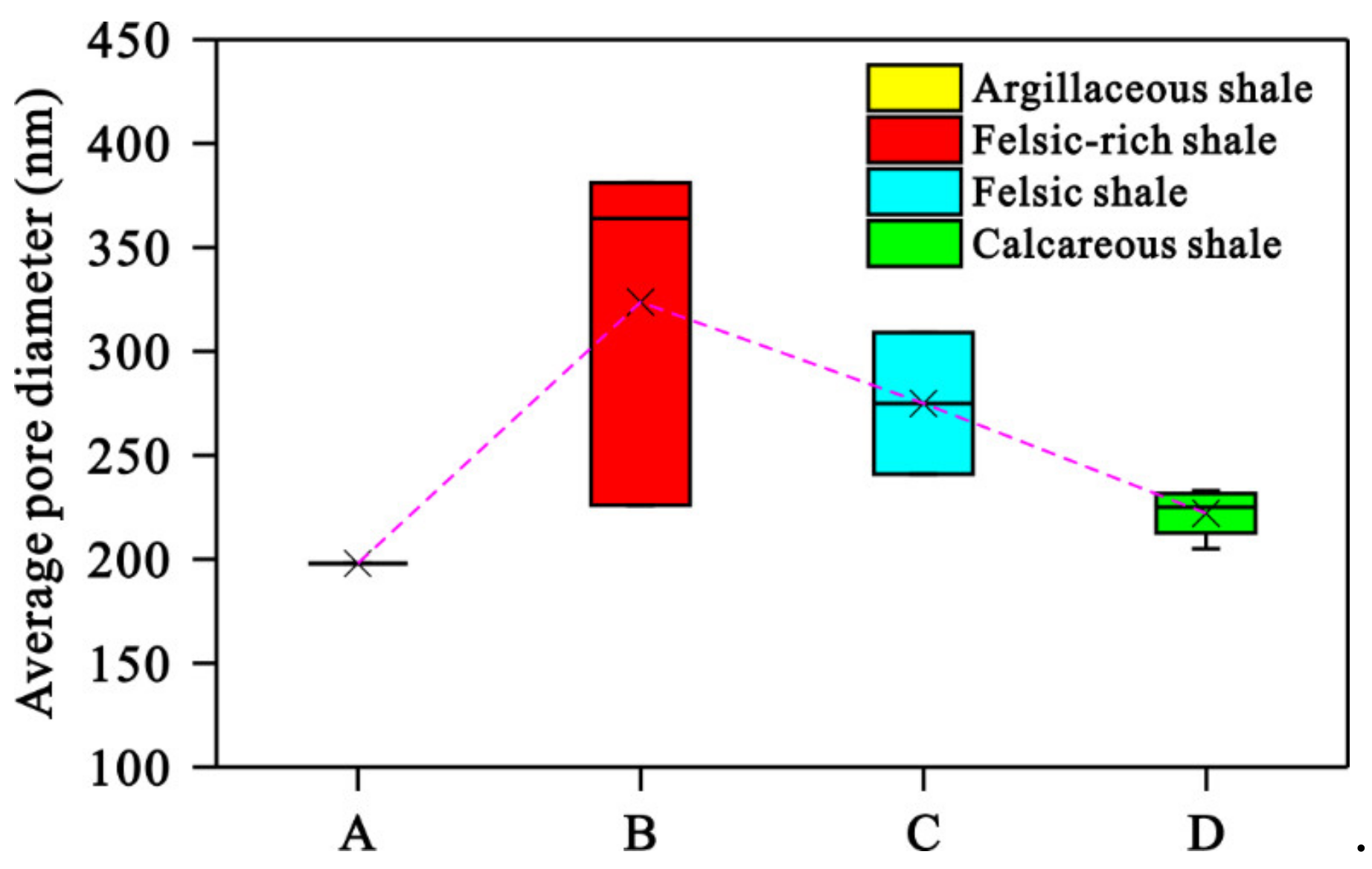


| Sample | Lithofacies | TOC | S1 mg/g | Clay Mineral/% | Quartz % | Orthoclase % | Feldspar % | Calcite % | Dolomite % | Pyrite % |
|---|---|---|---|---|---|---|---|---|---|---|
| S1 | argillaceous | 1.44 | 0.22 | 55.5 | 30.8 | 2.1 | 7.9 | 3.6 | ||
| S2 | felsic-rich | 1.66 | 0.29 | 14.0 | 38.7 | 5.8 | 18.5 | 11.2 | 6.6 | 0.5 |
| S3 | felsic-rich | 0.32 | 0.09 | 32.1 | 37.7 | 4.8 | 10.5 | 2.3 | 8.3 | |
| S4 | felsic-rich | 0.36 | 0.09 | 28.9 | 40.0 | 2.8 | 14.2 | 1.8 | 8.9 | |
| S5 | felsic | 0.67 | 0.17 | 39.8 | 30.8 | 1.8 | 11.1 | 6.1 | 10.3 | |
| S6 | felsic | 0.51 | 0.10 | 36.7 | 24.1 | 1.5 | 10.1 | 16.7 | 5.9 | 5.1 |
| S7 | calcareous | 2.60 | 1.51 | 40.7 | 17.5 | 0.9 | 3.1 | 26.5 | 1.8 | 4.5 |
| S8 | calcareous | 2.68 | 0.46 | 37.0 | 20.0 | 1.7 | 2.5 | 31.6 | 2.2 | |
| S9 | calcareous | 2.58 | 1.25 | 38.5 | 19.8 | 1.6 | 2.2 | 26.6 | 6.8 | 4.5 |
| S10 | calcareous | 2.52 | 2.96 | 30.0 | 26.0 | 0.2 | 2.7 | 18.7 | 17.5 | 4.8 |
| Sample | Lithofacies | SEM Images Number | Resolution/nm | Pore Number | Fracture Number |
|---|---|---|---|---|---|
| S1 | argillaceous | 9 | 10.4 | 2255 | 23 |
| S2 | felsic-rich | 6 | 23.83 | 3526 | 76 |
| S3 | felsic-rich | 4 | 12.84 | 1368 | 7 |
| S4 | felsic-rich | 4 | 23.83 | 2119 | 78 |
| S5 | felsic | 9 | 10.4 | 1975 | 64 |
| S6 | felsic | 9 | 10.4 | 3373 | 16 |
| S7 | calcareous | 9 | 10.4 | 1599 | 6 |
| S8 | calcareous | 9 | 10.4 | 1032 | 6 |
| S9 | calcareous | 9 | 8.35 | 2937 | 14 |
| S10 | calcareous | 9 | 10.4 | 2694 | 40 |
| Sample | Porosity/% | Da*/nm | |||||
|---|---|---|---|---|---|---|---|
| Fracture | Interparticle Pore | Intraparticle Pore | Dissolution Pore | Intercrystal Pore | Total Pore | ||
| S1 | 0.120 | 2.724 | 2.015 | 0.019 | 4.758 | 198 | |
| S2 | 0.310 | 0.973 | 1.407 | 0.654 | 3.034 | 381 | |
| S3 | 1.778 | 3.606 | 2.157 | 0.804 | 0.018 | 6.585 | 226 |
| S4 | 0.092 | 1.037 | 1.402 | 0.035 | 2.473 | 364 | |
| S5 | 0.114 | 3.287 | 2.752 | 0.216 | 0.004 | 6.259 | 309 |
| S6 | 0.319 | 1.794 | 2.005 | 1.059 | 0.070 | 4.928 | 241 |
| S7 | 0.153 | 1.498 | 1.244 | 0.363 | 0.004 | 3.108 | 204 |
| S8 | 0.498 | 2.278 | 0.570 | 0.022 | 2.870 | 229 | |
| S9 | 0.789 | 3.986 | 2.050 | 1.104 | 0.104 | 7.244 | 232 |
| S10 | 1.910 | 4.521 | 1.951 | 0.091 | 0.485 | 7.048 | 219 |
Disclaimer/Publisher’s Note: The statements, opinions and data contained in all publications are solely those of the individual author(s) and contributor(s) and not of MDPI and/or the editor(s). MDPI and/or the editor(s) disclaim responsibility for any injury to people or property resulting from any ideas, methods, instructions or products referred to in the content. |
© 2023 by the authors. Licensee MDPI, Basel, Switzerland. This article is an open access article distributed under the terms and conditions of the Creative Commons Attribution (CC BY) license (https://creativecommons.org/licenses/by/4.0/).
Share and Cite
Wang, J.; Lu, S.; Zhang, P.; Zhi, Q.; Huang, H. Pore Distribution Characteristics of Different Lithofacies Shales: Evidence from Scanning Electron Microscopy. Processes 2023, 11, 1120. https://doi.org/10.3390/pr11041120
Wang J, Lu S, Zhang P, Zhi Q, Huang H. Pore Distribution Characteristics of Different Lithofacies Shales: Evidence from Scanning Electron Microscopy. Processes. 2023; 11(4):1120. https://doi.org/10.3390/pr11041120
Chicago/Turabian StyleWang, Junjie, Shuangfang Lu, Pengfei Zhang, Qi Zhi, and Hongsheng Huang. 2023. "Pore Distribution Characteristics of Different Lithofacies Shales: Evidence from Scanning Electron Microscopy" Processes 11, no. 4: 1120. https://doi.org/10.3390/pr11041120
APA StyleWang, J., Lu, S., Zhang, P., Zhi, Q., & Huang, H. (2023). Pore Distribution Characteristics of Different Lithofacies Shales: Evidence from Scanning Electron Microscopy. Processes, 11(4), 1120. https://doi.org/10.3390/pr11041120






